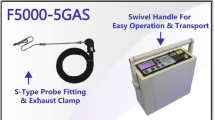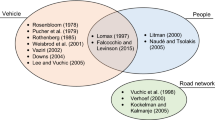Abstract
Heavy-Duty Vehicles (HDVs) on highways are among the major passengers and freight traffic carriers that occupy any space available on the roadway. The movement of HDVs under the mixed traffic environment causes higher levels of interaction between vehicles due to their physical and operational characteristics. Besides, the HDVs operating at less than their desired speed on the highway lanes cause a mixed traffic platoon formation. The primary purpose of the study is to investigate the impact of multi-class HDVs on the speed and flow rates of each highway lane under platooning conditions. In this study, traffic data was collected using an Infra-Red (IR) sensor-based device at six highway sections in India. The simultaneous equations approach is used to model the traffic speeds for determining the Dynamic Passenger Car Unit (DPCU). The speed-flow plots are established for Median Lane (ML) and Kerb Lane (KL), a minute before the arrival of HDVs (state A) and a minute after the arrival of HDVs (state B) at the IR sensor detection point, to quantify the impacts of HDVs on the speed and traffic flow rate. The study findings reveal that the speed and flow in ML and KL reduce significantly due to the influence of multi-class HDVs in the general traffic mix. Also, the speed and flow rate in ML and KL decreased with an increase in the percentage of multi-class HDVs. However, this effect was found to be comparatively higher in the ML than that in the KL. Finally, this study sets out recommendations to mitigate the adverse impacts of multi-class HDVs on the highways to enhance the speed and flow rate.
















Similar content being viewed by others
References
Singh, S., Santhakumar, S.M.: Empirical analysis of impact of multi-class commercial vehicles on multi-lane highway traffic characteristics under mixed traffic conditions. Int. J. Trans. Sci. Tech. (2021). https://doi.org/10.1016/j.ijtst.2021.07.005
Al-Kaisy, A., Jung, Y.: Examining the effect of heavy vehicles on traffic flow during congestion. Road Transp. Res. J. 13(4), 3–14 (2004)
Moridpour, S., Sarvi, M., Rose, G.: Modeling the lane changing execution of multi class vehicles under heavy traffic conditions. Transp. Res. Rec. 2161, 11–19 (2010)
Al-Kaisy, A., Jung, A.Y., Rakha, H.: Developing passenger car equivalency factors for heavy vehicles during congestion. J. Transp. Eng. 131(7), 514–523 (2005)
Zhou, J., Rilett, L., Jones, E.: Estimating passenger car equivalent using the HCM-6 PCE methodology on four-lane level freeway segments in Western U.S. Transp. Res. Rec. 2673(11), 529–545 (2019). https://doi.org/10.1177/0361198119851448
Leong, L.V., Shafie, S.A.M.: Platooning behavior at two-lane, two-way rural roads with level terrain in Malaysia. Proc. In: Stanton N. (eds) Advances in Human Aspects of Transportation. 786. Cham: Springer (2019). https://doi.org/10.1007/978-3-319-93885-1_67
Aerde, M.V., Vagar, S.: Capacity, speed, and platooning vehicle equivalents for two-lane rural highways. Transp. Res. Rec. 971, 58–67 (1984)
Roh, C.G., Park, B.J., Kim, J.: Impact of heavy vehicles on highway traffic flows: case study in the Seoul Metropolitan Area. J. Transp. Eng. Part A: Syst. 143(9), 05017008 (2017). https://doi.org/10.1061/JTEPBS.0000077
Chandra, S., Mehar, A., Velmurugan, A.: Effect of traffic composition on capacity of multi-lane highways. KSCE. J. Civ. Eng. 20(5), 2033–2040 (2016). https://doi.org/10.1007/s12205-015-0479-9
Xiong, X., Xiao, E., Jin, Li.: Analysis of a stochastic model for coordinated platooning of heavy-duty vehicles. IEEE 58 Conference on Decision and Control (CDC) Palais des Congrès et des Expositions Nice Acropolis Nice, France, December 11–13, (2019)
Yang, D., Kuijpers, A., Dane, G., Sande, T.: Impacts of large-scale truck platooning on Dutch highways. 21st EURO Working Group on Transportation Meeting, Germany. Transp. Res. Proc. 37, 425–432 (2019)
Gattis, J.L., Alguire, M.S., Townsend, K., Rao, S.: Rural two-lane passing headways and platooning. Transp. Res. Rec. 1579(1), 27–34 (1997)
Webster, N., Elefteriadou, L.: A simulation study of truck passenger car equivalents (PCE) on basic freeway sections. Transp. Res. Part B: Methodol. 33(5), 323–336 (1999). https://doi.org/10.1016/S0965-8564(98)00036-6
Zhou, J., Rilett, L., Jones, E., Chen, Y., Zhao, L.: Quantifying platoon characteristics on four-lane level freeway segments. Proc. The 97th Annual Meeting of the Transp Res Board (2018)
Lu, P., Zheng, Z., Tolliver, D., Pan, D.: Measuring passenger car equivalents (PCE) for heavy vehicle on two lane highway segments operating under various traffic conditions. J Adv Transp 1–9 (2020). https://doi.org/10.1155/2020/6972958.
Chitturi, M.V., Benekohal, R.F.: Passenger car equivalents for heavy vehicles in work zones. The 87th Annual Meeting of the Transp Res Board (2007)
Hangfei, L., Qiang, F.U., Hongjun, Z., Xiaofang, Y.: Influence of heavy vehicles on traffic flow in highway work zone based on delay analysis. J. Tongji Univ. Nat. Sci. 3(36), 335–338 (2008)
Shukla, S., Chandra, S.: Simulation of mixed traffic flow on four-lane divided highways. J. Ind. Rd. Cong. 72(1), 55–69 (2011)
Bains, M.S., Ponnu, B., Arkatkar, S.S.: Modeling of traffic Flow on Indian expressways using simulation technique. Proc. Soc. Behav. Sci. 43, 475–493 (2012)
Dhamaniya, A., Chandra, S.: Speed characteristics of mixed traffic flow on urban arterials. Int. J. Civ. Env. Eng. 7(11), 883–888 (2013)
Himes, S.C., Donnell, E.T.: Speed prediction models for multi-lane highways: A simultaneous equations approach. J. Transp. Eng. ASCE 136(10), 855–862 (2010). https://doi.org/10.1061/(ASCE)TE.1943-5436.0000149
Greenshields, B.D.: A study of traffic capacity. Proc High Res Board 14 (1935)
Indian Highway Capacity Manual (Indo-HCM): New Delhi: Central Road Research Institute (2017)
Singh, S., Santhakumar, S.M.: Evaluation of lane-based traffic characteristics of highways under mixed traffic conditions by different methods. J Inst Eng (India) Ser A. (In-Press) (2021)
An assessment of the uncertainty achieved by the CEOS TIRTL calibrator: Clayton: National Measurement Institute (2004)
Kotzenmacher, J., Minge, E., Hao, B.: Evaluation of portable non-intrusive traffic detection system. Minnesota Department of Transportation, Research Services Section, 29–34 (2005)
Centre of Excellence in Urban Transportation, Indian Institute of Technology Madras: Development and evaluation traffic sensors under Indian traffic conditions, A subject-project sponsored by the Ministry of Urban Transportation, 48–64 (2016)
Singh, S., Barhmaiah, B., Kodavanji, A., Santhakumar, S.M.: Analysis of two-wheeler characteristics at signalised intersection under mixed traffic conditions: A case study ofTiruchirappalli city, Resilience and Sustainable Transportation Systems, Proc. of the 13th Asia Pacific Transportation Development Conference, Shanghai, China, American Society of Civil Engineers (ASCE), 35–43 (2020). https://doi.org/10.1061/9780784482902.005
Highway Capacity Manual: Highway Research Board Washington D.C. (2016)
Indian Roads Congress (IRC): 64 (1990) Guidelines for Capacity of Roads in Rural Areas, Indian Roads Congress, New Delhi.
Singh, S., Panda, R.K., Saw, D.K., Santhakumar, S.M.: Effect of heavy transport vehicles on speed-flow characteristics of mixed traffic on multi lane divided intercity highways. Resilience and Sustainable Transportation Systems. Proc. of the 13th Asia Pacific Transportation Development Conference, Shanghai, China, American Society of Civil Engineers (ASCE). 176–185 (2020). https://doi.org/10.1061/9780784482902.021
Singh, S., Shukla, B.K., Santhakumar, S.M.: Infra-red sensor-based technology for collecting speed and headway data on highways under mixed traffic conditions. Proc. of the 7th International Conference on Signal Processing and Integrated Networks (SPIN-2020), Amity University, Noida, India, Institute of Electrical and Electronics Engineers (IEEE). 607–611 (2020). https://doi.org/10.1109/SPIN48934.2020.9070829
Ferrari, P.: The effect of the competition between cars and trucks on the evolution of the motorway transport system. Transp. Res. Part C: Emerg. Tech. 558–570 (2009)
Al-Kaisy, A., Karjala, S.: Car-Following interaction and the definition of free-moving vehicles on two-lane rural highways. J Transp Eng 136(10), 925–931 (2010)
Singh, S., Kumar, A., Niyas, M., Santhakumar, S.M.: Multivariate analysis of freeways speed and time headway under mixed traffic streams. Proc. of the 2020 International Conference on COMmunication Systems & NETworkS (COMSNETS), Bengaluru, India, Institute of Electrical and Electronics Engineers (IEEE). 116–121 (2020). https://doi.org/10.1109/COMSNETS48256.2020.9027497
Moridpour, S., Sarvi, M., Rose, G.: Effect of Surrounding Traffic Characteristics on Lane Changing Behavior. J. Transp. Eng. 136(11), 973–985 (2010)
Liu, X., Xu, J., Li, M., Wei, L., Ru, H.: General-logistic-based speed-density relationship model incorporating the effect of heavy vehicles. Math. Probl. Eng. 1–10 (2019). https://doi.org/10.1155/2019/6039846.
Gao, J., Liu, B., Kong, L., Guo, Z.: Study on the influence of heavy vehicles on freeway safety. Light Veh 29(5.29), 19–24 (2004)
Singh, S., Vidya, R., Shukla, B.K., Santhakumar, S.M.: Analysis of traffic flow characteristics based on area-occupancy concept on urban arterial roads under heterogeneous trafficscenario—A case study of Tiruchirappalli city. Proc. In: Y. A. Mehta et al. (eds.), Advances in Water Resources and Transportation Engineering, Lecture Notes in Civil Engineering,149, 69–84 (2021). Springer Nature, Singapore. https://doi.org/10.1007/978-981-16-1303-6_6
Singh, S., Santhakumar, S.M.: Evaluation of lane-based traffic characteristics of highways under mixed traffic conditions by different methods. J. Inst. Eng. India Ser. A. 102(3),719–735 (2021). https://doi.org/10.1007/s40030-021-00549-6
Acknowledgements
The authors would like to recognize and appreciate the research facilities provided by the Centre of Excellence in Transportation Engineering (CETransE), National Institute of Technology Tiruchirappalli, India.
Author information
Authors and Affiliations
Corresponding author
Additional information
Publisher's Note
Springer Nature remains neutral with regard to jurisdictional claims in published maps and institutional affiliations.
Appendix
Appendix
Rights and permissions
About this article
Cite this article
Singh, S., Santhakumar, S.M. Platoon-Based Impact Assessment of Heavy-Duty Vehicles on Traffic Stream Characteristics of Highway Lanes Under Mixed Traffic Environment. Int. J. ITS Res. 20, 29–45 (2022). https://doi.org/10.1007/s13177-021-00268-z
Received:
Revised:
Accepted:
Published:
Issue Date:
DOI: https://doi.org/10.1007/s13177-021-00268-z




